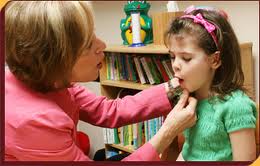- How does speech develop?
- What are speech disorders?
- How are they caused?
- How is it diagnosed?
- What is the treatment?
How does speech develop?
Speech is a component of language by which humans communicate with each other through spoken words. Language also has other components which aid communication but are not verbal in nature.
The most important period for normal speech development in humans is the first three years of life. This is the time when the brain is maturing and is at its receptive best and can be maximally stimulated for talking. This is known as the “critical period” for speech acquisition.
The infant begins by crying for food or when he is uncomfortable. By around 2 months of age, the infant starts coo-ing which is a repetitive sound consisting only of vowels. By 6 months, the baby starts to combine vowels and consonants to produce sounds like ‘baaa-baaa’, which is called babbling. By the end of the first year most children are able to say a few simple words like “dada”. This ability to speak enhances by the end of the second year, where a child is able to combine two words to communicate his wishes. Though these are the broad milestones for speech development, speech development varies with individual children.
What are speech disorders?
Speech disorders refer to difficulties in producing speech sounds or problems with voice quality. There may be a problem in the flow of words (stuttering), unclear production of speech, or problem with the volume and pitch of voice. There may also be trouble in using certain speech sounds like substitution of ‘f’ with ‘s’ (lisping). The child may also have the problem of limited speech where he may not talk at all or may have trouble talking in specific situations.
How are they caused?
There may be many reasons for speech disorders:
* Physical defects present from birth including deformity in the vocal cords, wind pipe or the mouth region. Conditions like cleft lip or cleft palate predispose a child towards speech difficulties.
* Hearing impairment or deafness is another cause of speech disorder. Children need to hear sounds in order to learn and imitate them.
* Damage to the brain or the nervous system may be another cause of speech defects. These defects depend on the area of the brain that is damaged. For example, if the cerebellum is malformed, there may be problems in the coordination of speech sounds thus producing clumsy speech.
* Specific disorders like autism or Down’s syndrome increase the chances of a child of having speech defects.
* In some cases, psychological trauma may cause a child to deliberately stop talking. There may be other underlying causes for this psychological disturbance.
How is it diagnosed?
Parents are usually the first to notice the disorder in the child. A paediatrician may then diagnose the problem after taking the patient’s medical history and a physical examination. A hearing test may be done to rule out deafness as a possible cause. Other tests like a CT scan may be ordered to examine any nervous system damage. In cases where a psychological disturbance is suspected, the child may be referred to a child psychologist for confirmation of the condition.
What is the treatment?
The treatment depends on the cause. In children who have a physical defect, an operation may have to be done to correct the problem. In children with hearing impairment, a hearing aid is fitted and speech therapy is started as soon as possible. For all children, speech therapy is done in addition to the medical or surgical treatment. Speech therapy helps to clear the child’s diction, pitch and tone of voice or stuttering.



